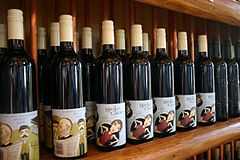Vintners Quality Alliance

Vintners Quality Alliance, or VQA, is a regulatory and appellation system which guarantees the high quality and authenticity of origin for Canadian wines made under that system in British Columbia and Ontario. It is similar to regulatory systems in France (AOC), Spain (DO), Italy (DOC), and Germany (QmP). The VQA system allows for sub-appellations, by which the grapes for wines are sourced from extremely specific geographical locations with different soil and climate. This is in accordance with the concept of terroir.[1]
In addition, there are other classifications of wine in Canada. British Columbia has a category known as "Wines of Distinction" and Nova Scotia has "Wines of Nova Scotia". Both must be 100 percent made from grapes grown in British Columbia or Nova Scotia. Cellared in Canada is a completely separate category.[2]
Requirements

In addition to the requirements regarding sources of grapes, VQA wines may be made from Vitis vinifera grape variety and approved hybrid varieties. In British Columbia, VQA wines are made primarily with vinifera grapes, while Ontario uses a range of vinifera varieties and notably permits the use of Vidal, particularly in the production of some of Canada's icewines.[3]
VQA wines may be made with grapes from relatively small agricultural yields per vine (which increases quality), they meet specific sugar or brix levels at harvest, and the use of additives is regulated. There are also standards regulating the use of certain types of packaging and closures. To receive the VQA designation, wine must undergo testing by the regulating bodies. There is no standard location on the bottle for the VQA logo.
Appellations
Ontario appellations and sub-appellations
Total production for Ontario appellation wines is approximately 20,000 tonnes.
- Regional Appellations:
- Regional Appellation - Lake Erie North Shore
- Regional Appellation - Prince Edward County
- Regional Appellation - Niagara Peninsula (includes all appellations below, Canada's largest)
- Collective sub-appellation - Niagara Escarpment (includes the 3 sub-appellations below)
- Sub-appellation - Short Hills Bench
- Sub-appellation - Twenty Mile Bench
- Sub-appellation - Beamsville Bench
- Collective sub-appellation - Niagara-on-the-Lake (includes the 4 sub-appellations immediately below)
- Sub-appellation - Niagara River
- Sub-appellation - Niagara Lakeshore
- Sub-appellation - Four Mile Creek
- Sub-appellation - St. David’s Bench
- Sub-appellation - Vinemount Ridge
- Sub-appellation - Creek Shores
- Sub-appellation - Lincoln Lakeshore
- Collective sub-appellation - Niagara Escarpment (includes the 3 sub-appellations below)

British Columbia appellations
(total production for 2006 20,000+ tons)
- Regional Appellation - Okanagan Valley
- Regional Appellation - Similkameen Valley
- Regional Appellation - Fraser Valley
- Regional Appellation - Vancouver Island
- Regional Appellation - Gulf Islands
There are no sub-appellations in the province of British Columbia.
Organizations
Regulatory
- British Columbia Wine Institute (the regulatory role is being transferred to the new British Columbia Wine Authority, which will be a government body).
- Vintners Quality Alliance Ontario, is a regulatory agency of the Province of Ontario that administers the Ontario VQA Act.

Marketing & Advocacy
- British Columbia Wine Institute
- Wine Council of Ontario
- Winery Association of Nova Scotia
Other organizations
- B.C. Grape Growers Association (represent independent growers).
- Association of B.C. Winegrowers (represents smaller and fruit wineries).
- Grape Growers of Ontario (represent growers and negotiate the prices of grapes).
- Ontario Wine Producers Association
References
- ↑ J. Robinson (ed) "The Oxford Companion to Wine" Third Edition pg 759 Oxford University Press 2006 ISBN 0-19-860990-6
- ↑ G. Hamiliton "Sale of cheap imports as B.C. wines called 'scandalous'" National Post Vancouver Sun, September 20th, 2009.
- ↑ J. Gordon (ed) Opus Vino pg 126-130, DK Publishing New York 2010, ISBN 756667511